










By Daniel Lin & Roger Lu

We used to go to the Stop and Shop [on Needham Street], so having [a new grocery store] back there will be very convenient. We'll de nitely be using it.
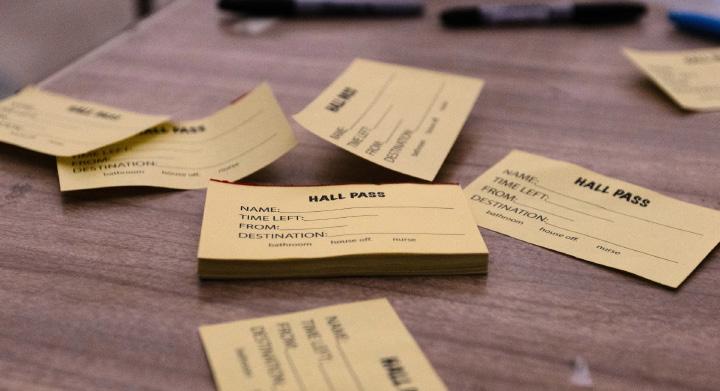
In an attempt to address student absenteeism, South reinforced its mandatory attendance policy for WIN blocks at the beginning of the school year. Now, students must remain in their originally scheduled WIN classroom for a full 10 minutes before relocating to another WIN. If a student wishes to leave the classroom at any point during WIN, they must carry with them a yellow “hall pass,” which explicitly states the approved destination. Under these stricter protocols, WIN attendance now o cially counts for academic credit.

We're quite excited to get a Trader Joe's to replace a Stop and Shop that went out of business. We've been waiting excitedly, and wondering why it isn’t built yet.
Henry

After much speculation, Trader Joe's has o cially announced plans for a second Newton location. is new store — which will be located at 1165 Needham Street — will replace a former Stop & Shop location, which abruptly closed its doors in August 2024. With the opening of this new store, a wider variety of grocery options will be available to the Newton community. An opening date has yet to be announced.

e Massachusetts Seal, Flag and Motto Commission has settled on three nalists to replace the current state ag. ese new ag options re ect either the state's geography, animal and ower or rich history. e commission will examine the nalists in the coming months, with a nal recommendation deadline of Dec. 15, 2025. is recommendation will be presented to Governor Maura Healy and will undergo further legislative action to be o cially adopted.
I think it’s unnecessary to have stricter rules because it’s so much harder to move around to get where you need to go.
Teachers are less stressed now because there are always lines of kids in WIN asking to be switched in, and it wastes time for students who actually need help.
Javi Nashat Class of '27

I think that Massachusetts [is] a very diverse state, and [we] try our best to create a space or community that sort of embraces all the di erent perspectives, ideas and cultures that people bring to the table.
Hae-Kyoung Choi
Newton South Counselor
We're people with a complicated history, sometimes proud, sometimes painful, but it's ours. I don't think the lesson is to erase the past or pretend it didn't happen, but face it honestly and learn from it.
Mike Kennealy Republican Gubernatorial Candidate via CBS News
Amelia Nincic, Allora Chaudhari & Cameron Holbrook News Contributors
At the Sept. 24 School Committee meeting, Newton Public Schools (NPS) superintendent Dr. Anna Nolin presented her plan to revamp the math curriculum.
!is new model includes separating math classes by level starting in the seventh grade and changing how math topics are grouped.
!e goal is to have students end their middle school years covering topics up to Algebra 1.
Nolin said the plan will ensure that accelerated students are challenged and that struggling students receive the necessary support.
“What we're proposing are intervention services for students in WIN block, extension block at middle schools [and] summer jump up programming for students who want to strengthen their skills, remediate any math di"culties they have or advance themselves in some way,” she said.
Nolin said that while the value of multilevel classes is a heated debate in Newton, the city is in agreement that the math curriculum needs an upgrade.
"[In] the surveys that we completed about our current math program, educators, students and parents were all in agreement that a change was needed,” she said.
Jill Galli, a sixth grader at Day Middle School, said that she would prefer math classes separated by level to the current single-level classes.

being held back. !at's not fair for either side.”
Nolin said that the new plan for the math curriculum will allow students to reach their full potential in math.
“Mathematics courses often can be gateways for future experiences,” she said.
“We just want to make sure that our systems are not keeping anybody back and acting as a
Galli said the proposed changes to the curriculum will increase students’ motivation in their math
“I think [the students struggling in math] could be more excited to have some group work time [and] actually go over every -
However, Summer Lin, a seventh grader at Brown Middle School, said that leveled classes could take a toll on students’ selfesteem.
“Some people might not feel as con$dent or comfortable if they are not at the highest level,” she said. “So, it might put pressure on kids who want [to be there] instead.”
While Nolin is not critical of extracur-
ricular math opportunities, she said she hopes that parents do not feel the need to enroll their children in such programs due to de$ciencies in NPS math programming.
“I feel that as a good public school system, we should be able to provide those di erentiated math experiences for students,” she said.
However, Nolin’s new plan does not come without challenges. Nolin said that the most substantial barrier to her proposal is the state of city $nances.
“!ere's just been a lot of budget cuts over the last six years,” she said. “Math specialists, who provide and design both intervention services and advanced student experiences, have been cut almost completely at the middle school level and don't exist at the high school level.”
Virgilio said that enhancing the school curricula is a worthwhile investment for the city.
“One of the number one reasons people move to Newton and pay a lot of money to live here is for the education,” she said.“It's supposed to be top-notch.”
Nolin said that another barrier for the new curriculum could be a fear of letting go of the way math has always been taught.
“Everybody [has] had math classes, no matter where they went to school,” she said. “!ere's a lot of nostalgia for whatever happened to them. Whether it was good or bad, people want to recreate that system.”
Still, Nolin said that Newton’s educators can adapt to these changes.
“Change is always hard,” she said.“Sometimes it's scary, but I believe our teachers possess the teaching capacity and talent to meet this new demand.”
On Sept. 8, the Massachusetts Bay Transportation Authority (MBTA) rolled out a new fare policy which places fare-checking representatives aboard vehicles and at stations to ensure that all travelers pay for transit.
Since 2021, the MBTA has lost $27 million annually, on average, due to passengers avoiding the fare.
!e MBTA’s Green Line has been the hub of fare evasion. !e contactless payment systems and absence of turnstiles at the line’s numerous above-ground stations have made it easier for travelers to get on without paying, according to local sources.
Some of these stations include Newton Centre, Newton Highlands and all stations further west, which tend to be the stations most frequented by South students. MBTA fair revenue deputy chief Elizabeth Winters Ronaldson said that ensuring that all passengers pay will help mitigate the losses.
“Having riders pay for their fares is really the best way for riders to help sustain the MBTA and pay for all the things that we all rely on: good service, clean buses, frequent service, things like that,” she said.
Senior Ori Zhdanov said that since the change, they have noticed that more and more MBTA customers have been paying consistently, which they appreciate.
“[With the policy], I get my money's worth, because sometimes I would get a ticket and never use it because the conductors would say, ‘oh, don't [pay].’”
However, Boston University (BU) student Grace Bian said that the fees accumulate over time, which can be a burden for many riders like her.
“$2.40 each time I need to get somewhere a little farther than just [BU’s] campus … really does add up very quickly,” she said. “All of us are college students. We're all either in debt or broke, so it's kind of rough.”
English teacher Joe Golding said that with representatives stationed at T stops, he feels safer in almost empty T stations.
vent low-income travelers from accessing the T.
“[!e policy] could bar some people from using the T, especially someone who might not be able to pay the fare. It could make getting around the city a lot harder,” they said.
Lanciloti said that the policy could cause an uptick in commuters applying for reducedfare programs.

“I think it's great to have someone there in public space,” he said. “It's nice that there's a fully employed person whose job is monitoring [fare payment].”
Senior Forest Lanciloti said that he has noticed that representatives also help riders when needed.
“[What] I've seen with them more is [tourists] asking them for help and directions, which I thought was really interesting,” he said.
However, Zhdanov said they worry that the policy and the new representatives can pre -
“[!e policy] will probably scare people into signing up for [reduced-fare] programs, which is probably a net bene$t because it can accurately re ect the needs of the community,” he said.
Junior Rowan Perkinson said that she has concerns about the T and its unreliability, so she thinks the MBTA should focus on resolving technical problems rather than fare enforcement.
“I guess [the MBTA] loses a lot of money, but it’s also breaking all the time,” she said.“!ey
sometimes have to retire a line for a month at a time, so I feel like they should focus on better service before making people pay.”
Lanciloti said that the new policy might be the answer to improving the quality of the T.
“Hopefully … with the money that they make from actually getting people to pay for the T and $nes, we will give them a little more money in their operating budget.”
Bian said that her local community has had to adapt to this new policy.
“I have heard a lot of complaints from my friends at BU about this fare policy ... It's a warning that's been going throughout campus, like ‘be careful, they're gonna start making people pay.’”
Ultimately, Lanciloti said the community will have to see how commuters respond to the policy as time goes on.
“It really depends on how e ective it is,” he said.“If [the policy] is very e ective, … then it’s a good use of the money, but if it's like how it went in New York, where police didn’t do much, and it's just not e ective, that will be a waste of money. It’s a trade-o .”
[With the policy], I get my money's worth, because sometimes I would get a ticket and never use it because the conductors would say, 'oh , don't pay.'
Ori Zhdanov Class of '26

John Chaimanis is running for his rst term on the City Council. Currently, he runs a company focused on creating clean energy facilities. He also has three children attending NPS.
While this is his rst time running for City Council, Chaimanis said it is not his rst time getting involved with local politics.
“I’ve been active in Newton politics for about ve years,” he said. “I’m a very active volunteer as a youth sports coach ... and generally around my neighborhood."
Chaimanis said that if elected, he will focus on education, Newton’s nances and the local economy.
“My top priorities are the schools, the budget and supporting local businesses and healthy commercial activity,” he said.
Chaimanis also said that it is important to help small businesses thrive.
“We cannot understate the importance of continuing to maintain healthy and attractive commercial spaces in our community,” he said.

Lisa Gordon is running for Ward 6 City Councilorat-Large. She is currently the Executive Director of the Acton Food Pantry, and has been a civil rights activist since she was in college. Gordon said that she has raised her family in Newton, and she wants to give back.
“For me, this isn’t about politics. It’s about service. It’s about helping Newton continue to be a place where everyone feels they belong,” she said.
If elected, Gordon said that she hopes to focus on sustainability, a ordable housing and community engagement.
“Newton would be well served by a biodiversity plan to go along with our Climate Action Plan,” she said. “We can look at buildings and policy, but we also have to make sure we’re protecting the biodiversity we have now.”
She also said that she values civic participation, especially for youth.
“"e more people involved, the better our decisions will be,” she said. “I’d love to see more residents, especially younger ones, take part in city discussions.”

Long-time Auburndale resident and architectural designer Cyrus Dahmubed is running for City Council for the rst time.
Dahmubed said that his experience in design has helped him prioritize issues facing Newton.
“My background is in design, so I think of priorities like integrated design solutions,” he said.
Dahmubed said that these priorities include housing and budgeting.
“It is really expensive to live in Newton … At the same time, we’re facing challenges in our budget, and in particular, in the way we fund our schools,” he said.“"ere’s more investment needed in the schools across the city, and there’s more investment needed for the future.”
He said that he wants to ensure that solutions proposed by the City Council work for everybody in Newton.
“[I hope to] listen carefully to everybody and come up with something that is a good starting point for us to actually work from, and get to a solution where everybody feels like they’re winning,” he said.

Newton resident Ted Gross is running for Ward 6 City Councilor-at-Large. Gross has lived in Newton for over 60 years. While this is his rst time running for o ce, Gross said that he is no stranger to local politics.
“I’ve helped other candidates and issues over the years, going out and campaigning for them, doing door knocking, dropping literature, the things that go on in a campaign,” he said.
Gross also said that sustainability is crucial, and responsible development is one of his main priorities.
“Houses should be deconstructed instead of torn down. "at saves land ll space, prevents pollution and allows materials to be reused,” he said.
Gross said that he's looking to take a more active role in the city he’s lived in for so long.
“I’ve been on the sidelines for many, many years, and I want to be at the table to be able to contribute and be part of the solution for our city as we move forward,” he said.

osh Krintzman has spent eight years on the City Council and is seeking a fth term. He serves as a member of the Council’s Zoning and Planning Committee and Chair of its Programs and Services Committee.
JKrintzman said that he has three top priorities for Newton.
“One, full support of the school system in the NPS … Two, repairing our infrastructure … "ree, responsible growth, so we can help our revenues keep pace with our expenses,” he said.
Krintzman said that he prioritizes collaboration between the City Council and the School Committee.
“[It is important to] support our superintendent and the policies that the School Committee has outlined,” he said.
Overall, Krintzman said that if reelected, he is looking to continue serving the citizens of Newton.
“I believe deeply in public service,” he said. “Public service is at a crossroads in our national landscape, and we are seeing public servants who are not interested in helping the public, but interested in serving their own good.”

Sean Roche is running for the Ward 6 City Councilorat-Large. Roche has been a transportation, housing and climate activist in Newton for 25 years.
Roche said that he advocates for these issues because he cares greatly about them.
“I’ve testi ed innumerable times at City Council meetings and spent a lot of time working with councilors on the issues that matter to me,” he said.
Roche said that much of the city’s policymaking happens before nal votes are taken.
“What happens in committee, shaping the things that end up getting voted on, is almost more important than how people vote,” he said.
Roche said that a major focus of his campaign is the connection between climate action and housing policy.
“"e relationship between housing and climate is something not enough people recognize,” he said. “Our zoning rules prevent us from building reasonable numbers of homes near transit, schools and village centers.”
The Roar spoke with each of the candidates running in this year's municipal elections. Read about their backgrounds, stances on key issues and more.
By Abby Miller & Sanjana Tewari

After growing up in Newton and graduating from North in 1982, Al Cecchinelli is running for Mayor for the third time. Cecchinelli, who has been a frequent attendee at planning, zoning and Historical Commission meetings said that his campaign is driven by concern for the city’s changing character and rapid development.
“We’re losing our character,” he said. “What makes Newton such a beautiful city is being strip-mined by the developers.”
He said that infrastructure is a key issue he’s focusing on, pointing to poor road conditions.
“Our roads are in horrible shape, and they’re making them far too small,” he said. “What they did at Washington Street is unacceptable.”
Additionally, Cecchinelli said that his campaign emphasizes managing education spending.
“We spend too much money on administration and not enough in the classroom,” he said. “We need to nd a way to cut administrative costs in both the city and the schools without seeing a loss in services.”

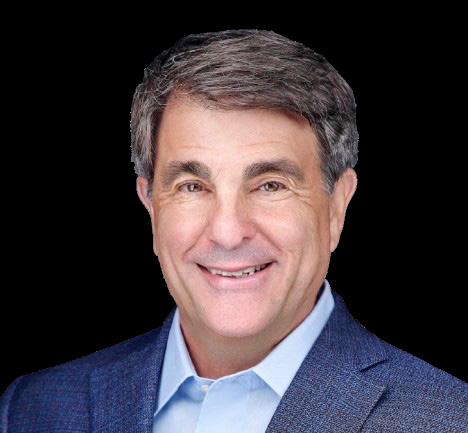
AMarc Laredo
fter serving for 13 years on the City Council, sitting president Marc Laredo is running for Mayor. Laredo previously served as a member of the School Committee for eight years and was elected Chair.
Laredo said that he feels fortunate to have grown up and raised his family in Newton.
“I love this community. Newton is just an unbelievably great place to live,” he said.
Laredo said that if elected, public education is his rst priority.
“It will be very important to me that I try to provide support for our teachers and always keep the best interests of our students rst,” he said.
Beyond the classroom, Laredo said that his priorities include renovating roads, maintaining sidewalks and caring for parks and recreation spaces in the City of Newton.
“We have nite resources, and every mayor grapples with that … we have to balance that with uncertain budget times ahead,” he said.
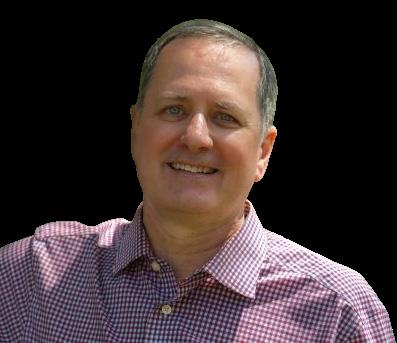
Newton voters elect o cials to the City Council every two years. Mayoral elections are held every four years.
Newton has eight wards, which are represented by a total of 24 City Councilors: Eight Ward Councilors, who are elected only by the residents of their ward, and 12 Councilors at-Large, who are elected by all Newton voters.
"erefore, the City Council has one Ward Councilor and two Councilors atLarge from each ward.
So, why are there only four contested races?
"e Ward 4 at-Large race, Ward 6 at-Large race and Ward 5 Councilor race are the only City Council races with more candidates than available seats.
"is means that incumbents John Oliver, Alison Leary, Tarik Lucas, Andrea Kelley, Rena Getz, Becky Grossman, David Kalis, Maria Greenberg, David Micley, Julia Malakie, Randy Block, Martha Bixby, R. Lisle Baker and Stephen Farrell will almost certainly be re-elected.
"ey will almost certainly be joined by newcomers Brittany Hume Charm, Brian Golden and Jacob Silber, all of whom are also running in uncontested races.
Mayor Ruthanne Fuller, who has served two terms, is not seeking re-election, leaving Al Cecchinelli and City Council President Marc Laredo to compete for leadership of City Hall.
Can I vote in all of these races?
All Newton voters can vote for Mayor, Ward 4 Councilor at-Large and Ward 6 Councilor at-Large.
Julie Irish, an Upper Falls resident of over 25 years, is entering her rst City Council race. Currently, Irish serves as president for her area council. She said that her top priority for Newton, if elected, is to support residents.
“My top priority would be to make sure that residents feel heard and represented. "ere are a lot of issues, and the issues will always change,” she said. “[I want to] represent the constituents in Ward Five.”
Irish also said that she would like to work on solutions to address the a ordable housing crisis.
“Newton is a desirable place to live, and the land value is high … we really have to gure out what we can do,” she said.
Above all, Irish said that she enjoys collaborating with Newton residents and they continue to be her main focus.
“I’ve gained a lot of experience and skills through working with the city and working with the residents and getting things done … I wanted to just take it a step further,” she said.
Having lived in Newton for 25 years, Garry Miller is running for City Council for the rst time.
Miller also serves as a member of the Neighborhood Liaison Committee for the Northland development in Upper Falls. Miller said that he decided to run for City Council because he wants to provide solutions for ongoing problems facing Newton and its residents.
“I kind of felt like, given the open seat and problems facing the city, I had something to o er, and it was time to try to take the next step,” he said.
Miller said that he has two top priorities.
“My number one issue is the schools, and that’s closely followed by housing and housing costs. It’s very di cult to choose,” he said.
Miller said that if elected, he is looking to resolve issues, particularly with the schools.
""ere’s really a problem with where the schools are and we need to get that straightened out to move forward," he said.
Only Ward 5 residents can vote in the Ward 5 Councilor race.
Make sure to vote on Nov. 4! Check your polling location here:

time for a policy that works for Newton residents.
We’ve all seen the signs. ey’re scattered across the lawns of Newton: “Repeal Parking Ban.” While the slogan is just something to pass by for many of us, it represents a very real issue that is up for vote on the upcoming Nov. 4 ballot.
Newton has had an overnight parking ban in some capacity since 1936, but in its current form it exists as a 2 a.m. to 6 a.m. street parking ban from Dec. 1 to March 31.
An e ort to repeal the ban, led by NPS graduates Peter Klapes and Jeremy Freudberg, gathered over 10,000 signatures of support in 2023, but has faced some resistance from City Council and has not appeared on the ballot until this year.
ose in favor of maintaining the ban claim that removing parking restrictions would overwhelm streets and create safety hazards, especially during snow emergencies.
While these concerns are valid, the bene ts of removing the ban outweigh the drawbacks.
Additionally, by formulating more nuanced policies, the city can mitigate the negative e ects of street parking.
Newton is home to an increasing number of apartments and multi-family homes, where tting cars in garages or playing tetris
with them in driveways is not always a realistic option. Repealing the ban allows for exibility for families, while also accommodating more outlying dynamics, such as needing space for an at-home health aide to park.
New apartment constructions are part of the argument to keep the ban, as some worry that legalizing street parking will make developers less disposed to provide parking within complexes, overwhelming streets.
However, there are options for local governments to mandate parking accommodation in new developments, with room for those requirements to be waived based on factors like proximity to public transport.
Furthermore, the weather safety argument feels moot.
e Newton Police, Fire and Public Works departments have each stated that repealing the ban would not pose any threat to public safety.
And — although it’s a little depressing — it doesn’t snow as much as it used to. When it does, we have much better ways of predicting incoming storms than we did in 1936.
Beyond speculation about the potential e ects of removing the ban, we also have concrete evidence that the city can manage parking tra c without the blanket ban: for two winters

e Lion’s Roar, founded in 1984, is the student newspaper of Newton South High School, acting as a public forum for student views and attitudes.
e Lion’s Roar’s right to freedom of expression is protected by the Massachusetts Student Free Expression Law (Mass. Gen. Laws Ann. ch. 71, Section 82). All content decisions are made by student editors, and the content of e Lion’s Roar in no way re ects the o cial policy of Newton South, its faculty, or its administration.
Editorials are the o cial opinion of e Lion’s Roar, while opinions and letters are the personal viewpoints of the writers and do not necessarily re ect the opinion of e Lion’s Roar e Lion’s Roar reserves the right to edit all submitted content, to reject advertising copy for resubmission of new copy that is deemed acceptable by student editors, and to make decisions regarding the submission of letters to the editors, which are welcomed.
e Lion’s Roar is printed by Seacoast Newspapers and published every four weeks by Newton South students. All funding comes from advertisers and subscriptions. In-school distribution of e Lion’s Roar is free, but each copy of the paper shall cost one dollar for each copy more than ten (10) that is taken by any individual or by many individuals on behalf of a single individual. Violation of this policy shall constitute theft.
during the pandemic, the ban was lifted, to no discernible negative outcomes.
Co-leader of the Keep the Ban movement Howard Rosenof told Fig City News “I want Newton to be a suburb of Boston, not an extension of Boston.”
Clinging to a version of Newton that no longer e ectively serves its residents for the sake of convention is not how policy-making should be guided.
In fact, we can look to Boston and other surrounding cities who do not have winter parking bans for guidance.
To counter concerns about students leaving their cars on streets surrounding Newton’s many college campuses, implement permit systems that allow only residents to park on the street; to allow for plows to clear the streets, impose temporary bans for the few occasions when the city declares a snow emergency, accompanied by parking contingency plans so residents are prepared when a snowstorm is in the forecast.
While, yes, it might be a logistical hardship to implement these new policies in a short time frame if the ban is repealed, the City Council has had plenty of time since this issue rst started gaining signi cant traction in 2023 — not to mention in the last 90 years
that this ban has existed — to draft alternatives.
Repealing the ban might be the push they need to actually do it.
e reason this issue is so contentious is that there is no one perfect solution. Short term, repealing the ban might ood streets with cars.
Long term, keeping the ban leaves the same residents frustrated and dissatis ed with local government.
To us, the long term feels more responsible to prioritize. Street by street, permit by permit, new policies will take e ort to formulate.
But Newton and its residents are worth the e ort.

Newton South High School’s Student Newspaper
140 Brandeis Road, Newton, MA 02459
ss.lionsroar@gmail.com
Editors-in-Chief
Andrew Feinberg
eo Younkin
Managing Editors
Ava Ransbotham Sarah Schwartz
Section Editors
News
Seyoon Byun
James Garrett
Abby Miller
Sanjana Tewari
Opinions
Angela Tao
Emily Wang
Grace Yang
Photo Managers
ayer Bialek
Lev Navisky
Centerfold
Hana Futai
Ellie Shim
Social Media Manager
Aleeza Amitan
Business Manager
Adam Ransbotham
Faculty Advisor
Ashley Chapman
Features
Laura Feng
Andrew Petrilla
Allison Sam
Bethesda Yeh
Sports
Clara Borus
Owen Halberstadt
Mitchell Lookner
Graphics Managers
Clare Cho
Ellen Wu

Theo Younkin Editor-in-Chief
ChatGPT made its debut in the fall of my freshman year, and, somewhat ironically, I learned about it for the rst time in English class.
It was a time of great speculation. I remember listening to podcast hosts remark, enthralled, about the tool’s ability to generate short stories in a matter of seconds. I remember watching my classmates learn to engage with it, captivated by its ability to solve math problems, answer complicated questions and engage in converstation.
But as fascinating as the new technology was, something about it felt fundamentally di erent from anything we'd seen before.
Some went as far as to suggest that the introduction of ChatGPT could mark the beginning of the end of the world. A recent article in e Atlantic featured a quote from AI researcher Nate Soares, who, convinced of an approaching AI apocalypse, declared that he no longer puts money into his 401(k). ese scenarios, thus far, have not come to fruition.
But, in a sense, AI is destroying the world as we know it in a di erent way.
We’re just not thinking the way we used to. AI has become so integrated into our daily lives that it's next to impossible to escape. e AI Overview at the top of every page of Google Search results eliminates the need to think critically about the internet, to browse websites
The art of the long-form essay is vanishing.
manually in search of information. Every study tool, from Quizlet to Duolingo, touts its newand-improved, AI-powered features.
None of this is to say that AI doesn't hold great potential. I’ve used the tool to learn and review math and science course material. It’s a laptop-sized tutor available at any hour, and the services it can provide in that regard are invaluable.
in the classroom that the tool is available to all of us, and there is little that a teacher or administrator can do to prove de nitively that anyone abused it.
e world of education hasn’t seen anything like this before. Even from a student’s perspective, it’s unsettling. I can’t imagine what it must be like to teach in this environment.
And yet, the way we're responding to it
We cannot give in. A world in which college and graduate students — the next generation of leaders, thinkers and academics — are incapable of producing long-form, thoughtful, high-quality writing is too awful to conceptualize.
But the devastating implications that the technology has had for the humanities — most notably, the English language arts — make me question if any of the advancements it's delivered are actually worth it.
At South, the dynamic in English, history and language classes has shifted considerably over the course of the last three years. AI has become the elephant in the room. ere is a mutual understanding between everyone

doesn't feel quite right, either. anks to AI, the art of the long-form essay is vanishing. Research papers are being replaced with inclass assessments.
e quality of the writing we produce in a 75-minute class period is nowhere near what we are capable of achieving if we are given the time to re ect, edit and revise, on our own time. at process is part of what makes writing so beautiful. How can students truly become
better thinkers and writers when technology is holding our education hostage?
Truthfully, I don't know. Most teachers, I can imagine, don’t want to be spending their time hunting for unauthorized AI use. And they shouldn’t have to, either. It's a sentiment that I can empathize with: At Roar, we believe that the usage of AI is a violation of journalistic integrity. But, at the same time, none of us want to be searching for the presence of the technology in the articles we edit.
And yet, we cannot give in. A world in which college and graduate students — the next generation of leaders, thinkers and academics — are incapable of producing long-form, thoughtful, high-quality writing is too awful to conceptualize.
We must preserve the long-form essay. at means, to a certain extent, accepting that AI might be able to in ltrate some assessments. But in the same way that we taught math after the arrival of the calculator and history following the introduction of Wikipedia, we cannot let the fear of dishonesty outweigh the importance of learning to think at a high level. e future of AI — and its implications for education — remain uncertain. We’re still guring out how to live, work and learn alongside it.
But we cannot let writing go down without a ght.


If ICE is to serve the people, it must be held accountable to the values of equality, justice and due process.
By Isa Folch & Serena Liu
Created in 2003 as part of the Homeland Security Act of 2002, Immigration and Customs Enforcement (ICE) was established primarily in response to the 9/11 terrorist attacks. According to the agency, its mission centers around safeguarding the safety and security of the people.
ICE has seen a dramatic shift in its role and scope in recent years, largely due to the Trump administration. Since taking o again in January 2025, President Trump has signi"cantly increased ICE's enforcement ac tivities nationwide, including in Massachusetts.
In June 2025, ICE began a Massachu setts-focused operation that, according to the Department of Homeland Security, targets “the worst of the worst criminal illegal aliens living in the state.” is derogatory and sweeping characterization not only criminalizes im migrants, but frames them as threats.
e Trump Ad ministration has made clear that it views all undocumented im migrants as criminals. For this reason, innocent people have been detained, and even legal residents live in fear, speculation and suspicion.
What the administration seems to have forgotten is that undocumented immigrants are not inherently criminals. A series of reports and statistics from Syracuse University showed that, as of this past summer, 71 percent of ICE detainees have no criminal convictions. Unfounded assumptions should never prede termine the course of lives.
ICE has attempted to recruit local of "cers in Massachusetts to participate in its mass deportation e historically uncooperative with ICE operations, remains a sanctuary state.
municipalities in Massachusetts have enacted these policies, meaning that municipal resources
rather, it is about systemically oppressing minorities and treating them as less than human.

The "sanctuary" term, though often disputed, generally describes a state or municipality that does not assist federal immigration enforcement agencies such as ICE. Numerous

permit and has no criminal history, yet he was detained by ICE. e wristband he was issued even had another person's name on it, showing how careless and dehumanizing the system is.
As of now, it seems as if ICE is not about stopping criminals or sticking to its stated goal;
detainees under the Trump administration have a criminal history, compared to 91 percent of detainees under the Obama administration, it is evident that the goal of the Trump administration was never to remove criminals, but to erase Latinos from the picture.
When innocent people, asylum seekers and families become the target of ICE raids, it becomes glaringly clear that ICE does not serve the people.
The Trump administration created this injustice, and they will not be the ones to dismantle it. Meaningful progress to reform systems requires leaders who are willing to
ICE was created to safeguard our country and combat transnational crime. Its purpose was to keep our country safe from criminals. Yet when innocent people, asylum seekers and families become the target of ICE raids, it becomes glaringly clear that ICE does not e value of national security cannot stated; however, true security does not come from terrorizing lawful immigrants, but protecting justice. ICE will not serve its purpose until its work is centered on criminals instead of minorities. In scapegoating Latinos, ICE has neglected its value and purpose, but, most of all, it has neglected the people it is intended to keep safe. is is not about national security; it is about racism.
If ICE is to serve the people, it must be held accountable to the values of equality, justice and due process. Otherwise, ICE serves to oppress, not to protect.
By Sofia Castillo, Molly Hadlow & Grace Yang
On Sept. 10, 2025, Charlie Kirk, a conservative activist and media personality, was assassinated. Kirk’s alleged assassin, Tyler Robinson, had left a message to his partner, saying,“I had enough of his hatred. Some hate can’t be negotiated out.”
at single message re ects more than one man’s anger. It encapsulates the intensity of a political culture which has allowed disagreement to morph into disdain, and disdain into rage. Violence has become the nal expression of polarization. It is no longer enough to disagree, a sentiment that has been a part of the American consciousness long before Kirk’s assassination.
e 1960s marked one of the nation’s most turbulent decades, beginning with the optimism of John F. Kennedy’s “New Frontier.” Kennedy promised progress on civil rights, space exploration and poverty reduction.
Yet Kennedy’s assassination — alongside those of Malcolm X, Martin Luther King Jr. and Robert F. Kennedy — shattered that optimism. ese horrifying acts left a generation disillusioned and sent shockwaves through sociopolitical movements. e violence of that era grew out of fears that change was happening too fast, or not fast enough. Americans, within the span of a single decade, saw what happens when political frustration festers into extremism.
Decades later, the cycle resurfaced. Domestic terrorism and violent stando s marked the 1990s, which Americans
otherwise fondly remember for economic

and Seattle riots that re ected racial and

tyrannical government that was responsible for the fatal Waco siege two years earlier.
e same decade saw Los Angeles
familiar. Over the past few years, America has witnessed a surge in politically motivated attacks and assassination attempts.


e Jan. 6 attack on the U.S. Capitol remains the most visible symbol of our political unraveling: a moment when electoral defeat turns into insurrection, and citizens storm the seat of democracy itself.
What makes this moment particularly dangerous is how normalized the violent rhetoric has become. reats against political gures have skyrocketed. Conspiracy theories thrive online, and distrust in the media and government has deepened. e di erence now is scale: digital platforms amplify outrage faster than institutions can contain it. Consequently, we are left with a country that increasingly sees opposing beliefs as moral evils. Violence begins to feel like well-deserved justice.
As students, we live in the spaces where political identities are rst tested and formed. Every classroom discussion, every online argument and every student publication shapes how our generation understands dissent. When we choose to listen, not attack; to challenge, not condemn, we push against polarization.
Political violence thrives in the absence of empathy. It feeds on fear, alienation and moral certainty. e antidote is not silence. It is instead the courage to understand before judging, to rebuild trust before it is gone.
We cannot undo the tragedies of the past or the divisions of the present. However, we can decide the direction of the future.
By Julia Ding
chatter at South.
Chronic absenteeism is undeniably an a major issue, as school attendance is required under state law. Being chronically absent — which Newton Public Schools nes as missing 10 percent of school days in a given school year — may negatively

After all, that 10 percent figure amounts to about two and a half
weeks of days missed, and absenteeism often results in a disconnection with peers, poor achievements in class and, worst of all, a decline in academic performance.
On one hand, South’s attendance requirements uphold this standard. However, they may result in missed extracurricular opportunities, therefore a ecting a student's life outside school.
For instance, the attendance policies were the reason I did not dance in a production of “ e Nutcracker.” e production required full commitment, which meant skipping classes when performances took place earlier in the day. is sacri ce made me hesitant, as I did not want to su er the consequences of missing classes in the afternoon. As much as I desired to audition, I had to give it up.
Aside from extracurriculars, though, there's a larger fundamental issue with the policies.
I remember dissecting the idea of freedom versus security in eighth-grade history class. omas Hobbes, an English philosopher, once said that total freedom would lead to societal chaos.
inking about this idea in the context of education, if there were no school policies, students would be roaming the halls, disrupting class and purposefully not attending school.
However, if there is too much security — or in our case, too many harsh policies — students may have their personal rights

Student liberty and policies need to be able to coexist. !is will not happen if there are not su"cient policies, nor if there are too many.
violated. erefore, as Hobbes also said, the key to a functioning society is a balance between freedom and security, between policies and personal autonomy. ese attendance policies, in tandem with the new WIN and hall pass requirements, are one part of creating a better school community.
Yet, rmly chaining students to their seats might end up creating more problems than solving them.
Student liberty and attendance policies need to be able to coexist. is will not happen if there are not su cient policies, nor if there are too many.
Perhaps listening to historic philosophers, nding a balance and being more tolerant will truly improve the school community as a whole. is approach accomplishes the goal of keeping students in their seats, yet still gives them that autonomy and freedom.

Fall is the perfect time for studying, wearing sweaters, drinking coffee and — of course — listening to some of the latest music.
By Seyoon Byun & Kaylee

Rising British artist PinkPantheress dropped her new mixtape, “Fancy !at” — a blend of UK garage, jungle and electronic pop — on May 9.
Featuring nine tracks, including wellknown singles like “Illegal” and “Tonight,” critics have praised the project for its cohesive sound production.
My "rst impression upon listening was, “Wow, this is very unexpected.” !e artist's earlier popular music — songs like “Pain” or “I Must Apologise" — leaned more into the “sad-but-hip” type of mood.“Fancy !at,” on the other hand, feels more outgoing and con"dent.
While PinkPantheress retains her dreamy vocal style on this mixtape, its production is much tighter, with a mash of energetic beats and a wide array of samples brought together by her signature somber feel. !e result is perfect for late-night study sessions or car rides.
Some of the album’s standouts include “Illegal,” a fast-paced beat with soft and lingering vocals. !e lyrics describe the feeling of doing something you know you will regret in the future.
Another notable track is “Tonight,”

American actress and pop singer Sabrina Carpenter released her new album
“Man’s Best Friend” on Aug. 29. But even before the music dropped, the bold album cover — depicting Carpenter on her knees — already began to stir debate and curiosity.
To me, her move was purposefully scandalous, a way to grab attention. But once you move past the imagery, the music has enough substance to stand on its own.
At "rst, the album felt chaotic, almost overwhelming. Each track seemed like an unexpected mix of elements, with country-pop, disco-pop and synth-rock all stitched together with Sabrina’s signature sarcastic, witty lyrics.
But the disorder quickly reveals itself to be intentional: the tracklist is like an on-again,
which perfectly blends bittersweet lyrics of dealing with a confusing situationship with rhythmic and upbeat instrumentals.
But my favorite is de"nitely “Stars.” Starting o strong with the lyric, “Why’d you wanna go and put stars in your eyes,” the cute track talks about the uneasy feeling of keeping secret dealings with a fun dance oor beat. !e song’s unique ending — it fades out with a call as opposed to a slowdown and fade-out — makes it stand out even more.
What really makes this mixtape work is its ability to be consistent. Each track ows naturally into the next, creating a seamless listening experience that almost feels like a movielong song rather than little bits and pieces.

o -again relationship, with constant swings of "ghting and self-doubt and sudden bursts of clarity or disgust.
“My Man On Willpower” captures the su ocating feeling of being emotionally dependent on someone else, while “Don’t Worry I’ll Make You Worry” uses whispers and somewhat threatening lyrics to portray the desire to confuse the other person in the same way.
Plus, the order of the tracks makes the album feel less like a playlist and more like an unraveling story. Stand-out tracks include “Manchild” and the viral “When Did You Get So Hot?”
But to me, the real gem is “Sugar Talking,” a perfect blend of humor and vulnerability that lingers long after you’ve "nished listening. Although the lyrics might come o as playful and unserious, underneath, the song digs into the resentment that builds when sweet words are never backed up by real actions.
What ties the album together is Sabrina’s ability to inject each song with humor and authenticity, to make dirty jokes while keeping the song catchy. It’s an incredible talent re ected across the entire album.
You might not want to live through all the pain, but you’ll de"nitely want to keep listening.
Da

Kali Uchis tells the newest chapter of her story in her album “Sincerely.”
Released on May 9, Uchis’ album gifts us lyrics and melodies in exchange for a slow dance. I lie down on my bed, and I wonder at the album’s silkiness owing into my ears.
Uchis’ music has always been about writing a letter, delivering a story of love, grief and love again.
You can hear it in the weary, hopeful exhale that opens “Sugar! Honey! Love!,” or the way “It’s Just Us” feels like a quiet, de"ant promise.
While the album might be a letter to her loved ones and past self, the emotions Uchis conveys are universal and pull listeners in. For example, in “Heaven Is a Home,” she sings, “!is is a story of a girl / Who was once imprisoned by her own mind / And freedom’s never felt this good.”
!e album is not without fault, however. !e lack of varied production techniques and notable changes in beats per minute across songs results in an album that struggles to capture listeners’ full attention — the tracks feel like the familiar, thoughtless habits of everyday life.
Above all, though, the album does an

amazing job in conveying a strong message of love.
!e "nal song on the album, “ILYSMIH,” is addressed to Uchis' newborn son:“But this moment was worth all the pain / He's living proof that dreams do come true / Look at you / Ooh, I love you so much it hurts.”
!e silkiness of her voice isn’t just soft; it's strong.
Each song is a di erent patch in the quilt of Uchis’ artistry, made from the fabric of a healed heart.
The album doesn't ask you to find yourself in her story, but simply to listen to its truth, from the "rst sentence to the "nal, sincere goodbye.
I’ve been transported to my dream destination, thanks to the Taiwanese band Sunset Rollercoaster: their songs take me back to the bright, nostalgic neon signs and dully-lit lamps in far East Asian towns.
On Aug. 8, Sunset Rollercoaster released their album “QUIT QUIETLY,” invoking citrus breezes with each lyric.
On the indie track “Humor Tumor,” Sunset Rollercoaster muses bitterly about how “Someday I’ll be gone, you will see / You know I was here, never free.” !e song is an exploration of morality, repression and internal struggles; it is an expression of the belief that true legacy is one of captivity, not freedom.
Looking back on the past is a staple of the band’s music. For them, it is not a choice,

but a necessity in their search for a new life. “Mistakes” emphasizes this re ection: “Life is so strange / People never change / We stumbled again on the same mistakes.” !e upbeat guitar and brimming bass feel like a physical push forward. Still, the contrasting melancholy lyrics, which repeat imagery of stumbling backwards and feeling trapped in life’s shackles, evoke the sense of a cyclical mantra closing in. However, after moving on to a new track, Sunset Rollercoaster is no longer stuck in the past. In “Bluebird,” they sing, “Put purple on my cheeks / Just let my blue lips softly speak to you / Put grey on my wings.” !e lyrics contain language that is constantly in motion, revealing a subtle change in emotions. !e band's usage of color continues accordingly: “Put yellow on my cheeks / Just let my green eyes softly blink at you / Put ash on my wings.” !roughout “QUIT QUIETLY,” this brilliant symbolism changes the meaning of the lyrics, just as the compositional elements do. From regrets to motion, mistakes to musing, Sunset Rollercoaster concludes their manifesto of personal uprising in “Fading Out,” singing, “I can live without the heavenly weight that held me down / Yet here we are, brothers I’ll be fading out.”
While October can be pretty spooky, nothing is scarier than a personality analysis…which is exactly what this article aims to provide.
By Abby Miller
You make it known that autumn is your favorite season. !e minute the temperature drops below 70°, you can be seen sporting a sweatshirt or scarf with a pumpkin chai latte in hand. Daylight Savings Time can’t stop you, given the amount of sugar you consume from just a few pieces of candy corn. Your pumpkin carving skills are cause for envy, and though it’s hard to "nd your candy of choice in a Halloween candy bowl, you love October so much that it doesn’t even matter to you.

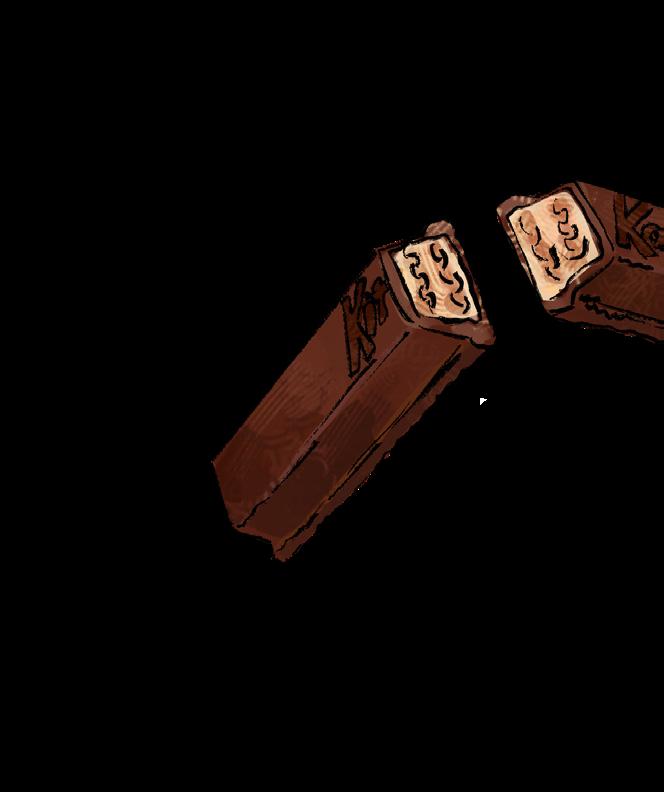
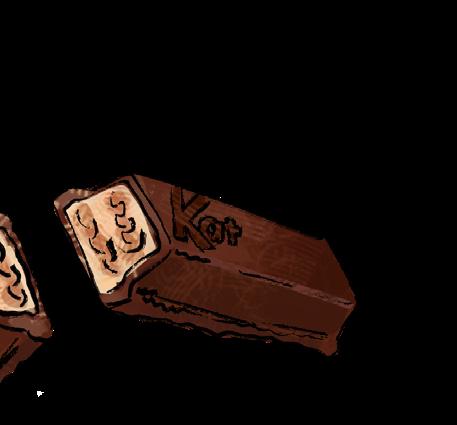

You aren’t afraid to be basic. You know what you like, and luckily for you, this makes for an easy trick-or-treating experience. There’s a possibility that you’re appalled at the new Skittles variants, which include Smoothies Skittles and Shriekers Skittles, neither of which I can explain. However, if you’re an expert in the Skittles "eld, you may be able to. You must also have an excellent imagination, because research shows that every Skittle tastes the same, and your brain only substitutes the avor.
You probably have a very strong avor preference, and it’s probably the pink one. Luckily for you, Starburst has started selling avor-speci"c packages. When you don’t get to choose, you beg your friends to trade for your favorite avor, and you may have even been told you’re too picky about your candy preferences. Don’t let anybody tell you what you should want — it’s good to have opinions! However, if you covered your eyes and tasted each Starburst avor, would you really be able to tell the di erence?
Ihave one question for you: How do you eat it? If you’re a casual KitKat enjoyer, you probably take a bite without a second thought. It’s likely you didn’t even know there was another way. You’re easygoing and don’t sweat the small things. However, if you’re a true connoisseur, you know that the only way to truly enjoy both wafer and chocolate is to dissect it with your teeth. You also know that it prolongs the enjoyment and provides entertainment, two things that are probably important to you.
You’ve probably been told you’re an “old soul”. You know there are more objectively interesting candies out there, but you "nd comfort in a simple piece of chocolate. Sometimes, if you’re feeling wild, you appreciate the almond Hershey’s but feel no pressure to branch out: !e brand is prevalent for a reason. At some point, you’ve probably dreamed about dropping everything and moving to an isolated farm hundreds of miles away. You can’t share Hershey’s bars with sheep, though...
Anyone who says Sour Patch Kids are their favorite candy also likely experiences a lot of nostalgia. One bite of those people-shaped delicacies, and you'll be immediately transported back to your second grade classroom. You can recall playing with Play-Doh, munching on the candy you once found intolerably sour. Maybe it’s because Sour Patch Kids were invented in the '70s, or maybe it's because there’s something seemingly juvenile about child-shaped candies, but either way, Sour Patch Kids provoke sentimentality.
It’s clear you aren’t afraid of commitment: most candies have varying avors, but not Reese’s. I applaud you for staying true to the chocolate and peanut butter combination, and you likely also stay true to those around you. Given your devotion, I wouldn't be surprised if you faithfully celebrate “I Love Reese’s Day” every year on May 18. When you care about something, you care a lot — some would even say you’re the glue holding things together…or maybe you’re the peanut butter?
Anybone who picks M&Ms out of a trick-or-treat bowl de has a color preference (and it might be green…). M&Ms are another incredibly popular candy, but many prefer their M&Ms with air. Pretzels M&MS? Almonds? Peanuts? No matter what your M&Ms include, you know you can rely on the chocolate candy whenever you need. You’re exible, easygoing and a lot of fun to be around. You probably love the colorcoded M&M personalities and have spent too long pondering which "ts you.




You probably had a brief phase where you secretly ate sidewalk chalk. Don’t worry, it happens to the best of us, speaking as someone who hid under her bed and ate lip balms at age seven. Smarties are an excellent substitute texture-wise, and the candy's name alone proves your intelligence. You like to mention that Smarties are your favorite given their obscurity and are likely faced with some“smarty-pants” related joke. Don’t let it get you down — as Smarties says in their slogan, “only Smarties have the answer.”


At the start of 2025, a reported 77 percent of public schools nationwide had implemented school cell-phone bans, according to e National Center for Education Statistics. Beginning last fall, Newton Public Schools has followed suit, implementing a strict no-phone policy during all classes, WIN blocks and advisory periods. In the following months, many students realized the intensity of their phone addictions.
“Doomscrolling,” a term initially coined during the COVID-19 pandemic, has been widely defined to mean endless scrolling through bad news. Now, as phone addictions worsen, mindless scrolling poses greater threats to teens’ and children’s productivity, attention spans and social awareness in their school lives and beyond.
South parent and pediatrician Deena Solomon said that teenagers are purposefully using technology to isolate themselves from the demands of reality.
“Rather than dealing with situations that they're in, whether it's social interaction with a group of people, or feeling lonely, teenagers are using their phones and social media as a crutch to dissociate themselves from what's going on in the world around them,” she said.
Wellness teacher Amy Aransky said that phone addictions follow the same neural reward pathways as the brain’s response to drug consumption.
“In Brain Train, you watch a video on how the addiction pathways are the same for any drug [or] cell phone. It's the same pathway,” she said. “I’m hopeful that [the video] helps students really be present in class.”
South parent Pranshu Tewari said that resorting to social media and entertainment platforms only provides temporary relief from anxieties.
“Because you don't deal with the problems in front of you, the problem still remains,” he said. “It's the same as using drugs or alcohol. [It] basically distracts your mind and your focus on something else with substances.”
In fact, temporary distractions could even worsen these issues. Commissioner of Newton's Department of Health and Human Services Shin-Yi Lao said that exposure to online content can exacerbate pre-existing mental health challenges and increase anxiety amongst teenagers.
“[Technology] might distract you [and] make you feel happy in the moment, but it doesn't x the underlying issue and can unfortunately contribute to more serious mental health issues,” she said.
graphic by Ellie Shim

to escape from reality.
“Social me dia particularly is designed to draw in and keep scrolling and scrolling,” she said. “ e algorithm is presenting you with things you like that you can quickly con sume and move onto the next thing.”
Tewari said that his at tempts to regulate his children's technology use has had limited success, and technology’s con trol over teenagers has become impenetrable.
“I don't think a change in parental technique matters, because I think everyone is addicted to their phones now,” he said. “So other than just trying to create guardrails for how much phone access you can control, there's really not much more I think you can do.”
Regardless, Tewari said that as a parent, he continues to encourage his child to be more aware of their technology usage while maintain ing healthy relationships with them.
“When [my child is] studying for a test, or [my child is] writing for a college application, areas where you have to be so focused, I can encourage and coach her to not have the phone around,” he said.“Other time frames, I've sort of given up because then you become this nagging parent and that leads to a bad relationship.”

In the classroom, teenagers’ reliance on technology challenges their academic success. Health and Wellness department chair Patrick Jordan-Quern said that as students’ patience and communication skills deplete, classroom
What I see as a pediatrician is a large discrepancy between a young kid's emotional intelligence and academic intelligence. Dr. Deena Solomon South Parent

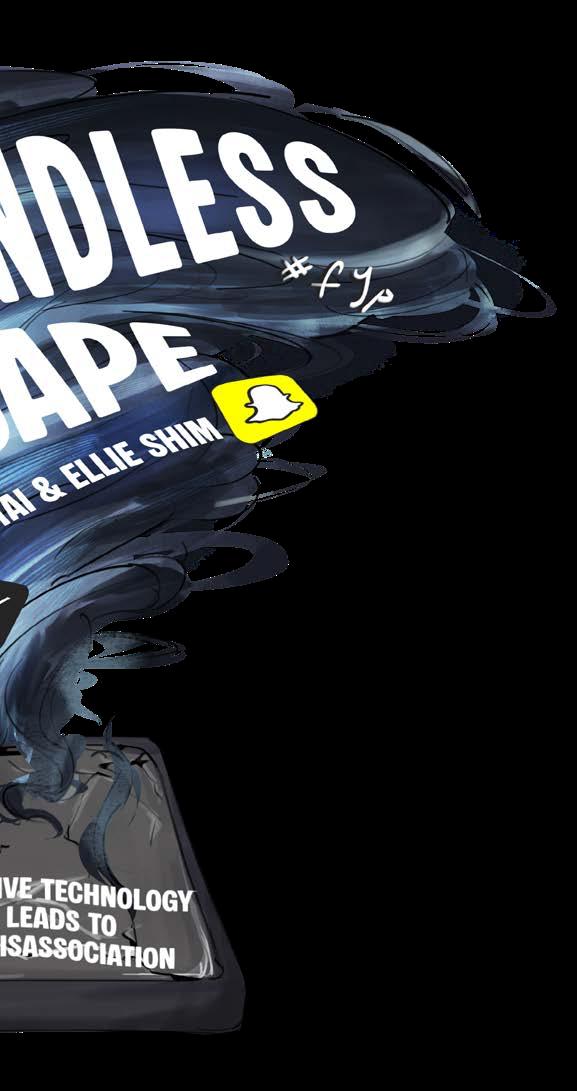
If people can nd ways to do work that they enjoy, contribute to society [and] help other people, I don't think they'll need to escape anything.
Pranshu Tewari South Parent
proactive about their consumption of media.
“It's much more important that [teenagers] gure out for themselves what their limits are and how much they need to distance themselves from [technology] sometimes, because this is something that they're going to need to manage in their lives for the rest of their lives.”
Estin said that he encourages users to break their habitual phone use.
“Just as an experiment, put the phone in another room. Just sit down and do whatever it is that ‘doesn’t matter’ and see how long it takes,” he said. “You’ll see if you don't feel as tired afterwards, [and] you might nd that you get your homework done twice as quickly.”
Since setting productive goals for himself, senior Callum Morgan said that he’s been motivated to pursue healthy escapism alternatives.
“Realizing that you have to put in that time and e ort to achieve something, you know that the time that you're using on your phone isn't important,” he said. “Setting goals is something that I've done for myself recently this year, just kind of nishing a task one by one and slowly improving every single day.”
Additionally, Morgan said that destressing through sports allows him to step away from school and immerse himself in a tightknit community.
“Face-to-face human interaction with your teammates, coaches and opponents is much more bene cial for you [than screentime] in the long run, because you're getting a physical bene t as well as connecting with people that you love and care for,” he said.
Ultimately, Tewari said that escapism wouldn’t be a necessary coping mechanism if people focused on productivity that brings them ful llment.
“ e reason we look for escapism is we're not doing things that make us happy. We don't feel like we're contributing. We don't have a purpose,” he said. “If people can nd ways to do work that they enjoy, contribute to society, [and] help other people, I don't think they'll need to escape anything.”




Local residents and businesses gather in Newton Centre to put on a fall festival for the community.
From live music to books to face painting, the annual Harvest Fair in Newton Centre, organized by Newton’s o ce of Cultural Development, o"ers it all.
Director of Cultural Development Paula Gannon said that the Harvest Fair, celebrating its 50th anniversary this year, draws vendors and attendees from Newton and beyond.
“[Harvest Fair] is all about highlighting the great businesses, the organizations and the talent that we have here in Newton, sharing that amongst ourselves and with others outside of Newton,” she said. “We should be very proud. We have a really wonderful community.”
Dave Carroll, founder of Newton music school the Conservatory at Highland, said that the Conservatory has been performing and vending at the Harvest Fair since its founding nine years ago.
“Since the beginning, it always made sense to participate in these fairs to complete our goals: giving students opportunities to perform, spreading the word about music education and meeting families,” he said.
Gannon said that the fair sets up two performance stages for various music and dance groups, including adult rock bands and student ensembles.
“[ e rst stage] gives our local musicians, music schools and dance studios a chance to come out and showcase what they do for the community,” he said. “ e other stage is the main stage where I bring in professional bands.”
Anjini Mishra, founder of small busi-
ness Kathya, will be vending home decorations with hand-crafted Indian textile designs at the Harvest Fair for the rst time. Mishra said that she is excited to share her work inspired by her culture with the Newton community.
“I grew up seeing [my mother] decorating living spaces with beautiful textiles from di"erent parts of India, and a little bit of that is in me as well,” she said. “Given that there is so much diversity in textile craft forms in India, I wanted to bring some of that to the global market.”
Mishra said that she prefers participating in local community-based events like the fair over ones that are larger or farther away.
“I feel [local events] are far more successful, not just in terms of sales, but overall … it's so much more enriching to be part of these community events and markets,” she said.
Not only does the Harvest Fair support established businesses, it also encourages individuals of various ages and experience levels to participate.
Writer Rosalind Yeh, an eight-grader at the Winsor School and founder of the Rosalind’s Bookstand booth, said that the Harvest Fair has supported young vendors such as herself in many ways.
“When I joined the Harvest Fair, there was a discount for vendors under 14,” she said. “ ey really do want younger vendors to be






there and experience having a business.” This will be Yeh’s third time selling her books at the Harvest Fair. Yeh said that the fair has helped her develop crucial life skills such as communication and con dence and encouraged her to write more books.
“Seeing that there were a lot of people in my community who supported me, and a lot of young kids who were inspired by my books, [it] encouraged me to continue writing, and I went on to publish my second and third books,” she said.
Maine-based Author Ashlee Ridlon, also known as Author Ash, uses events like the Harvest Fair to strengthen the bond between her and her readers. Ridlon said that her engagement with customers fosters a sense of community within her own booth.
“I love in-person events. ey're my favorite way to get my children's books out there because I'm able to meet potential readers,” she said.“I love helping [them] pick out the perfect book that they're looking for.”
e hard work and love that each vendor puts into their work comes, for some, with a sacri ce.
For kids, the highlight of events like the Harvest Fair is often the face paint. Sharon Zhang, founder of Newton Face Painting, said she is dedicated to creating a special look for
every child, but it is no easy feat.
“I paint more than 60 kids and then keep doing it all day,” she said. “I got really bad back pain when I got back home.”
Zhang said that seeing the children’s reaction to their face paint gives her the motivation to keep going.
“I love to make them beautiful [and] look at their smiles when they look [at] themselves in the mirror,” she said.
Much of the vendors' preparation work behind the fun- lled spectacle goes unseen. As a former vendor herself, Gannon said that these behind-the-scenes e"orts are the festival’s backbone and that recognizing vendors’ hard work is incredibly important.
“I do hope that the community comes out in a big way and is generous with these vendors. It really makes a di"erence,” she said.
[Harvest Fair] is all about highlighting the great businesses, the organizations and the talent we have here in Newton.
Paula Gannon Director of Cultural Development






“I love going to fall fairs with my family and friends. Going there is so fun because it unites our community and also allows small businesses to show off. I love getting food from small businesses to show my support. Going to fairs lets me try new things and explore.”
“I love apple pie. I hate pumpkin pie, though. Why would I put pumpkin in my pie? I wouldn’t put a vegetable in my pie. It’s supposed to be a sweet pie, a dessert. I’m not eating cabbage pie, broccoli pie, salmon pie. No, I’m just eating apple pie.”
“When I was little, we used to go apple picking, and we used to go to Davis Farmland and Drumlin Farm, which I miss. Those farms are so much fun because you can feed the animals … they eat off your hand and they go on your lap. It was so cute.”
“I love when it’s the perfect weather; it’s cold enough that you can wear a hoodie, but not cold enough to wear a coat. You can go on a walk and see the foliage around you. There are crunchy leaves, and it’s very quiet. I can just listen to music and drink a hot chocolate, and it’s perfect.”
Sophomore Isabel Sun said that while she was in Kelli Fitzgerald’s English class last year, Glickman came in to teach a few lessons.
When Professor Gregory Crane of the Epics of the Ancient World course at Tufts University approached Emily Glickman and asked her to be his teaching assistant (TA), she did not hesitate to accept. But Glickman said that the professor’s next words caught her by surprise.
“He was like, ‘Great, it’s in this prison,’” she said.
Glickman has experience teaching in unique circumstances, but it has all been part of a journey that led her to her rst year teaching English at South. While she arrived at college planning to major in classics, Glick man received her bachelor’s degree in child development.
At Tufts, she was a TA for Crane’s English class and taught at a prison through a program called the Tufts University Prison Ini tiative of Tisch College (TUPIT).
“I thought, ‘How incred ible [it is that] this program is about bringing a form of mental liberation in such a con facility?’” she said.“It was very eye-opening and transformative, so I've stuck with the program since then.”
Now a professor of her own course at TUPIT, Glickman said that she can contrast her experiences as a TUPIT professor and high school teacher.
“[At] a regular high school, people kind of have to show up, because that's what's ex pected of students,” she said. “ the same level of gratitude for education and what it really gives you as a person.”
“I could tell she's passionate about this, and she had a similar teaching style and vibe to Ms. Fitzgerald,” she said.
Now, Glickman is teaching her own junior and freshman English classes. Her mentor, English teacher Joe Golding, said that Glickman cares deeply about teaching.
“She has a ton of energy, she is very, very positive and she's excited, really excited to teach,” he said.“Some of us are old and need co she doesn’t need it as far as I can tell.”
Glickman attended an American high school in London. She said that her English
now implementing these discussions in her own classrooms at South.
“My philosophy is that every student's voice is heard in some way, shape or form, every day. "en, we make eye contact with each other and show each other respect by sitting all together in that circle,” she said.
“[I want] everyone to feel like they're on an even playing eld with me. I'm not your

what we read together.”
Junior Avery Utano, who is in one of Glickman’s classes, said that her class has already had multiple Harkness discussions this year.
“It's very new to me, but I think it's cool. It's a new way to learn,” she said.
While Glickman has not yet implemented Harkness discussions in her freshman classes, freshman Adrianna Goncalves said that Glickman’s teaching style already provides

“She's not talking at us. Whenever she asks a question, she lets us raise our hands,” she said. “She lets us do projects with other people, so we're not sitting at our desks and listening to her talk the whole class.” Freshman Gregory Cerruti said that he enjoys Glickman’s emphasis
“We get different seats in every class,” he said. “"ere’s always moments where I get to sit with my friends, and then the next day I’ll sit with people I Glickman said that while this year is her rst teaching a class that is entirely her own, she always tries to bring her passion into the classroom.
“I live for this job. I think it's incredible, [it’s what] I've always wanted to do,” she said. “I want to always show up enthusiastic every day for the students.”

The Roar follows four seniors with different interests as they navigate the college application process and will reveal their identities and college plans as they make their decisions.
By Andrew Petrilla

Deep into her application process for West Point and the US Naval Academy, Alice* has to juggle all of the di"erent interviews, examinations and nominations she needs for her application.
With her physical examination to test her athletic abilities at the end of October, Alice said that she has been training harder than ever.
“I'm on a big time crunch to do the best I can,” she said.
Applicants are able to take the physical test multiple times, but once they submit a passing grade to the academy, they cannot resubmit it.
Alice recently completed an interview with an alumna of the US Naval Academy, known as her Blue and Gold O cer. e

During the summer, Kate’s* top schools were Barnard, Tufts and Wesleyan. Since returning to school and talking to college and career counselor Daniel Ho"man, she has expanded her list.
Now, it also includes schools from the Claremont Consortium, a group of seven independent colleges linked together in Claremont, California.
“ ey have a similar vibe to schools that I'm interested in in terms of being smaller schools,” she said. “ ey're connected in the consortium, so it's like a bigger school, but still small school vibes.”
Although she has not yet visited those schools, Kate said that she has heard good
After working hard for years to make an impression on college soccer recruiters, Mark* is nally starting to see his e"orts pay o".
He said that he is currently in the process of visiting colleges, networking with coaches and learning about di"erent schools.
“ is is honestly reaping the bene ts of the recruitment process,” he said.
College visits for those hoping to become athletic recruits can di"er from those of the average applicant. Mark said that he would often attend a class and then travel with the soccer team to a game to watch them play.
“You're getting a full perspective of what life as a student athlete would be at any of these schools,” he said.
interview took place at the library, and after talking for a while, the alumna wrote up a report for the academy.
For her application to West Point, Alice said that she was able to conduct the interview at a West Point Camp she attended this past summer.
“ ey made it a little bit easier for your application,” she said. “Because if you get accepted [to the camp], you're already a competitive candidate.”
Alice needs to obtain congressional nominations by Oct. 31 and Nov. 1, which she said has added another layer of complexity.
“ ose are kind of completely separate from the college applications themselves,” she said.
Originally planning on getting his musical theater college applications submitted by the middle of September, Liam* has had to adapt his plan to account for the realities of schoolwork. He said that he decided to focus on trying to get all of his applications done by the end of October.
“I've now begun individualizing around every single school's deadlines, just because of the crazy start to senior year,” he said.
is past August, Liam was able to professionally record his video auditions, which included multiple songs that he had been practicing since January. He said that they were enjoyable to lm and that he is pleased
things and thinks they could potentially be the right place for her.
“I know a couple people that go there and really like it,” she said.
While she had previously been planning on applying early decision, the expansion of her college list has made her decide to apply regular decision so that she is not forced to commit to one school.
“Before, I thought I was making an early application somewhere,” she said. “But there's not just one place that I'm attached to.”
Kate still hopes to get most of her applications submitted by Nov. 1. Her current focus is on editing and nalizing her supplemental essays and personal statement.
ese visits are crucial in giving student athletes a sense of the lifestyle at each school and helping them determine how much time they want to spend on coursework versus athletics. Mark said that is one of the key factors he is considering to help him decide the school he wants to attend.
“It's balancing how much of an athlete you want to be and how much of a student you want to be,” he said.
Currently, Mark is planning on applying early decision to Bowdoin, where he would be more focused on his coursework than soccer.
“Bowdoin would be a great place to end up in terms of academics,” he said. "My time after college would be a little bit easier just in terms of having opportunities.”
Another unique aspect of the military academies that Alice learned during her interview is their use of rolling applications, which means that applicants are selected shortly after they apply. is means that the sooner someone applies, the more spots remain open. Alice said that this has made the nal stages of her application highly stressful.
“I’m under a lot more pressure now to get it done in time,” she said.
While the deadline is Jan. 31, Alice hopes to apply well before then. Despite the complications, Alice said that she is persevering and staying determined until her applications are submitted.
“It'll hopefully be over soon, so [I] just kind of remind myself of that,” she said.
with the nal products.
“I'm super happy with them,” he said. “It's good to see it nally pay o".”
Given his artistic pro le, Liam’s next step is simply standing by until he hears back.
“It's mostly just a waiting game from now until most schools’ decision day for the rst round auditions,” he said.
e rest of his application has also come with some challenges. Liam said that he was surprised by the di culty of obtaining the large amount of necessary data for his application.
“It's more di cult to get all the information you need than I initially expected,” he said.
To avoid this, Liam urges other appli-
Additionally, she has had to compile and submit a large amount of information for her applications, something that she has found to be surprisingly tedious.
“I feel like I'm constantly answering different questions about myself,” she said. e return to school has also helped decrease her worry about the process a little bit. ough conversations around college applications have increased signi cantly and been a little stressful, she said that she has found it reassuring to know that everyone is in the same boat.
“[It] makes me feel a little bit better, but I still feel like there's a lot of pressure around it,” she said.
Bowdoin is also the most competitive of Mark’s top schools, so applying early decision could potentially give him an edge. Nonetheless, Mark said that a de nite advantage to UMass Dartmouth is the lower tuition costs.
“[I’d] go into that situation with a little bit less of a guilty conscience,” he said.“Because the [college] nancial burden is massive.”
With Bowdoin’s Nov. 15 early decision deadline approaching, Mark is under pressure to nish his supplements. Between school, soccer practice and his other commitments, it has been di cult to get everything done. Nonetheless, he said that he has pushed through it.
“I've found that attacking the problem, attacking the stress head on and confronting it, [is] the best way to do it,” he said.

cants to advocate for themselves and to avoid relying on others’ help.“If you let things just sit there and let someone else do it for you, they just never get done,” he said.
With all the di"erent parts of college applications added onto schoolwork and extracurriculars, it can be easy to feel dragged down by the workload.
Liam said that he has been able to combat this by staying positive and not allowing worries to incapacitate him.
“I'm seeing it one day at a time right now,” he said. “It might get overwhelming later, but right now, I want to have a good balance between college and normal school and social life.”


In Asheville, North Carolina this past summer, my wife and I went to Trader Joe’s to stock up the shelves of our daughter’s apartment. While I was away in the cereal aisle, my wife bumped into another shopper, Craig, who, somehow overhearing her French accent, said, “You seem so nice, not like most French people,” ri ng on the American stereotype that French people are rude.




Students and staff channel creativity, individuality and patience into homemade Halloween costumes.
By Leah Chin & Leena Choi
I came up to the two of them a little after their introduction to see them chatting a"ably, and when my wife mentioned that we were from Boston, Craig shared that he grew up in nearby Bridgewater, an o"er of proximity meant to bring us even closer together in the short-lived world of supermarket relationships, the slight about my wife’s French background now a thing of the past.
When it came up in our neighborly dance that my wife and I were both schoolteachers and that I taught in Newton, Craig said to me, “You must be Jewish then.” I wasn’t quick enough to absorb the inference our new friend was making, that because I worked in Newton, which has a robust Jewish population, I must therefore be a Jew — or perhaps, more sinisterly, that working in Newton would make me Jewish, as if from contamination. Because his chuckle seemed so benign to me, I said innocently, “I am Jewish,” and shortly after, our micro-chat ended.
Only when our conversation echoed back in my mind did I hear Craig’s Jewish joke for what it likely was, antisemitism in the dressing of the tired anti-Newton quip about the city being full of snobby Jews. He didn’t say all that, but that’s what I heard in the echo.
So should I have said something to Craig, whom I saw a moment later in the ice cream aisle, not to challenge or attack him with the assumption that he had meant to insult me but to alert him to the possible cutting impact that his comment might have on another Jew who worked in Newton whom he might meet someday?
“Craig,” I might have said, “whether you meant any insult by asking me if I was Jewish because I worked in Newton, know that some Jews can get o"ended by something like that. We sometimes get nervous about non- Jews making those types of comments.” at would be it — an invitation for him to either apologize or correct himself. Craig might have sneered and brushed me o" or earnestly thanked me for letting him know how some Jews might feel. Or something else, but I can’t know — because I didn’t say anything. I’m only saying it now.
I didn’t say anything because I was afraid, though I can’t say exactly what I was afraid of, maybe “causing a scene,” and so I missed a chance to follow through on an un nished encounter.
Like many of South Stage costume supervisor Dimanne Mota’s costumes, her foray into homemade Halloween attire was inspired by Pinterest. To recreate the Queen of Hearts look, Mota said she started by painstakingly gluing and hand sewing play ing cards to a skirt because she didn’t own a sewing machine.
“I’m a very hands-on person, so I just

Many Halloween costume enthusiasts turn to thrifting due to its versatil
gured things out from there,” she said. “If one thing doesn’t look good one way, I’ll adjust it. It’s about playing around.”


Someday, I hope to be ready to engage with a comment like Craig’s and be open to go wherever the interaction travels. I might lead with curiosity, even warmth, to wonder at what Craig was thinking about when he made his joke. And not turn away and look at the ice cream avors.

wig or temporary dye. Although creating her costume takes a lot of time, Demler said that
“It is a special experience because it's always cooler to wear things and show o" things that you've made yourself and spent a
Last year, Srinath’s costume was a Dungeons & Dragons character cosplay. She added personal touches to the costume: taking o" some of the wiring and frames in the glasses, styling the wig and doing her own makeup. Instead of looking for speci c inspiration, Srinath prefers to go with her gut. She said the last step of the costume-making process is always adjusting everything to her liking.
“[I] put it all together, see what else needs changing [and] change it until it feels right,” she said.
at DIY, Mota said creativity is more important than materials or sewing skills. “ rifting is so cool, and there's so many things out there,” she said. “So just be unique. box, outside of items’ [original] purpose.”

you so much more.” is year, Barry’s costume will be based on Byron Shire, a character he created at a liveaction role-playing camp. For the look, Barry will be repurposing a dinosaur mask, as well as wearing a tail, paws and a T-shirt with a lace chest window.
Barry said that a rewarding aspect of the entire costume-making process is nished product.
“If people compliment me on my costume, I could be like, ‘ anks, I made it,’” he said. “I get praise-hungry."
[my costume] is also inspired by the goth community.”





With sold-out Friday Night Lights games and unmatched energy in the student section, a new roar of spirit has taken over the Lions' Den.
By Amalie Martin
South is historically renowned in many areas, but athletics and the culture surrounding them have never stood out.
!is year, however, a new wave of spirit has shifted that narrative: Friday Night Lights games have been sold out, and games are more spirited than they've been in years as rowdy Lions fans ll the bleachers.
!is growth in school sports culture can be largely attributed to the e orts of new athletic director Keith Davie, along with the South Spirit Club, the Booster Club and student section leaders, seniors Ben Jolly, Keshav Kollipara and Lily Shapiro.
!is year, Davie planned a Sept. 6“North vs. South” day in an e ort to raise the camaraderie between the schools. Additionally, Davie planned the North vs. South football game — the second home game of the season — which brought hundreds of students back to school on a Friday night, selling out South’s Winkler Stadium for the second time this season.
Despite South losing the game to North, the energy remained high.
Since becoming South’s athletic director this fall, Davie’s e orts to improve the school’s sports scene have not gone unnoticed. Weekly motivational emails, a new approach to the preseason tradition of Lion’s Pride, and his eagerness to cultivate a spirited athletic environment are just a few of the many ways that Davie has already improved the conditions inside the den.
Despite the fun and invigorating role of being a student section leader — leaders publicize spirit themes, advertise events on Instagram and rally students during games by leading them in cheers — Shapiro said that obstacles that arise at games can dampen the atmosphere.
“!e biggest challenge has been people not coming fully dressed in theme or being inappropriate with their cheers,” she said.
Kollipara said that spirit goes beyond the aesthetic qualities of the stands: it also betters
athlete performance.
“It connects the crowd a bunch when everybody's wearing the same things or dressed up together,” he said. “It … fosters a sense of community, and then, I feel like it makes the team play better as well.”
Jolly said that high energy can boost a team’s performance, since the excitement and support from the crowd builds motivation among players.
“!e turnout at games makes teams perform better because when you have that positive encouragement and that loud atmosphere, when it's for you, it really can create a sense of energy and pride in your performance,” he said.
Junior Dahlia Firoozabadi has played in multiple Friday Night Lights games as a member of the girls’ varsity soccer team. She said that the enthusiasm in the student section motivates her on the eld.
“Whenever I'm playing in a game, if there are people cheering me on, it encourages me to
photo by Tara Tow gh

When
you have that positive encouragement and that loud atmosphere, when
it's for you, it
really can create a sense of energy and pride in your performance.
Ben Jolly Class of '26
do better,” she said.
In addition to the work of Davie and student section leaders, the Booster Club and South Spirit Club have promoted an incentive for students to attend more games: the Booster Pass. For just $20, students get admission to every home game for the entirety of the 20252026 school year.
Not only are they guaranteed admission to fast-selling games, but students also save money if they attend over four games.
Additionally, South’s Class of 2027, in collaboration with the Junior Boosters — a variation of the Booster Club — released a fall schedule highlighting one key game for each fall sport.
!e work of multiple groups to improve South’s athletics has been undeniably successful, but Davie said that he hopes to incorporate more spirit in the future, including several traditions that he's observed at other schools.
“I would love to have a pep band, see our mascot get involved a whole lot more and [have] youth teams at games,” he said.
Jolly said that he is planning on getting a megaphone to help him and his fellow student section leaders raise energy and get fans to cheer louder.
Sophomore Ade St. Cine said that he recommends all South students who haven’t attended a Friday Night Lights do so to enhance their high school experience.
“!ey’re missing out on having a great experience with a great student section and the game overall,” he said.
Janie Rosenberg Sports Contributor
Many sports teams focus solely on winning, fostering a cutthroat environment where athletes are taught that anything less than !rst place is unacceptable. Members of South’s dance team, however, focus on self-improvement and supporting one another instead.
is environment allows dancers to perform well at both fun, spirited football games as well as rigorous competitions, creatings experiences that make the team a special community for members and coaches alike.
Junior Ella Chal!n said that above all, she and her teammates prioritize fostering strong team spirit.
“It’s such a big dance community that we’re all there to support each other, even if we’re competing against each other,” she said.
New coach and South alum Juliana Rizza said that all of the team members are extremely dedicated to the team and the sport itself, with many participating outside of school, which creates a special community within South.
“I think the girls on the team just have such a love for dance,” she said. “It's nice to see they can do it at school, and they're also so passionate to do it through their dance studios as well. It's nice to see everybody so well rounded.”
Senior and captain Lila Karp said that she enjoys being on the team and spending time with her teammates, who she said are all encouraging regardless of what happens.
“Everyone just wants each other to get better. We're all each other's biggest supporters,” she said.
Junior Amelia Fricano said that the team’s bond is largely due to the long hours spent dancing and training together.
“Everyone has been very welcoming on the team, and spending 10 hours a week with them has given me a lot of time to get to know people and bond with them,” she said.
she enjoys several aspects of dance.
“I love the girls. I think everyone’s sweet,” she said. “We get to practice a lot of di erent skills, and I really enjoy my time at practice.”
Rizza said that when preparing for competitions, it is important that alternates learn the choreography well and attend every rehearsal.

Senior and captain Neta Spigelman said that growing up dancing with the same people helps form a close team camaraderie.
“You get to go through it together,” she said.“You get to grow and learn with each other.” is kind of support enhances everyone’s dance experience. Junior Avery Utano said that
“Even if you’re an alternate, you are still expected to be at all the practices,” she said. “You are learning all the same choreography, doing all the same skills. Whether or not you get a formation will be based on your ability to adapt.”
Karp said that when preparing for com-
petitions, the team focuses on executing each part of the routine to the best of their ability.
“It really just comes down to perfecting everything to the last detail, or just repetition and getting it through muscle memory,” she said.
Spigelman said that while competitions are enjoyable, they require lots of preparation and focus, and team members are expected to practice outside of team practices.
She also said that when practicing for a competition, it can be hard to strike a balance between being a supportive teammate and also competing for the front spot.
“It’s a real mix of ‘we love everyone, but we also want to be number one.’ It’s a really hard thing to balance, but in the end, it’s always positive,” she said.
Rizza said she hopes to bring her professional knowledge from dancing for the Celtics and the Connecticut Sun to the team and wants to help the team be more successful.
“I want to bring them to Nationals. I want to compete. I want to be a force to be reckoned with. I want more and better for this team,” she said.
Karp said that she is excited to help train the next group of dancers.
“I’ve been very content with my four years here, and I'm just excited for the younger girls to get to experience it now,” she said.
Spigelman said that while she is sad to be leaving, she is hopeful about the future of the team.
“It feels like these new coaches are ready to take on everything that we’ve passed down and that the dance team is just going to keep on going,” she said.
Tyler Germain & Bodhi Jathar Sports Reporters
For the !rst time since 2021, the Boston Red Sox were back playing October baseball earlier this month. A rollercoaster of a season ended with the Red Sox !nishing with an 8973 record and making the postseason with a roster unrecognizable from the team that reached the American League Championship Series four years ago.
Despite mediocre play during the past three seasons, anticipation was high among Red Sox Nation entering opening day. Fans believed that the team could improve on its 81-81 record from 2024 thanks to key o season improve ments and an exciting rookie class headed by Roman Anthony.
e team put a focus on the issues of pitching and defense in the o season, as the 2024 Red Sox allowed the eighth-most runs in the MLB. ey signed veteran closer Aroldis Chapman to a one-year deal and traded two prospects to the Chicago White Sox for All-Star starter Garrett Crochet.
e addition of three-time All-Star Alex Bregman provided not only an elite veteran bat to the lineup but also a goldglove defense to the in!eld.
However, the addition of Bregman led to a dilemma: Bregman was set to re place Rafael Devers, the Red Sox’s star hit ter, at third base. is led to spring-training drama, but, eventually, Devers reluctantly agreed to become designated hitter (DH). Devers’ move to DH seemed to rattle him at the start of the season. In his !rst games, Devers went 0-19 with 15 strikeouts, the most in the opening !ve games of a season in MLB history.
Sox had an incredibly disappointing start to the season. Devers rebounded after his slow start, and he and Bregman were swinging hot bats, but the team struggled to consistently score runs.
In early June, the Red Sox sat at 30-35, but they began to turn a corner entering a three-game home series against the New York Yankees. e Red Sox swept this series, and
nothing in return.
After the trade, the team su ered, following up a six-game winning streak with a six-game losing streak, and it felt like just another lost season for the Red Sox: the team held a 43-45 record entering July 3. However, leading up to the All-Star break, the Red Sox once again shocked fans by winning 10 games
shape the team’s identity.
Despite having among the toughest second-half schedules in the MLB, the Red Sox performed well down the stretch en route to a postseason appearance.

Despite an Opening Day win, the Red
recall when Mookie Betts was traded to the Dodgers in 2020 in exchange for what felt like
career complete game and led the American League in strikeouts, this winning streak helped
On Sept. 26, the Red Sox trailed 0-3 to Detroit in the fourth inning before coming back to win in walk-o fashion, 4-3. is was the squad’s sixth and !nal walko in the Fenway greens — this time, a triple from Rafaela that clinched a wildcard spot for the Red Sox. is was the perfect way to wrap up the regular season, and it set up a best-ofthree Wild Card series in the Bronx against the Yankees.
Game One saw a matchup between the teams’ two aces: Crochet and New York’s Max Fried. Crochet gave up an early home run, but then retired the next 17 batters he faced. A late two-run single by Masataka Yoshida led the Red Sox to a 3-1 win.
However, this would be the last win of the season for the Red Sox, as they failed to close out the series.
Two Boston natives led the way for the Yankees, as !rst baseman Ben Rice hit a two-run homer that led them to a 4-3 win, and pitcher Cam Schlittler tossed eight scoreless innings to !nish the series with a 4-0 shutout win. is was a crushing defeat for Red Sox fans, but it’s di$cult to consider the season a failure. Most fans entered the season expecting a Wild Card appearance for the Red Sox, which is where they ended up.
While they couldn’t make a magical postseason run this year, the Red Sox secured an elite and dominant ace in Crochet and a potential future superstar in Anthony to longterm deals, so the future is bright in Boston.
The recently founded Student Athlete Advisory Council aims to increase student voices in South's athletic department.
By Margot An & Clara Borus
For athletes at South, the incorporation of student voices into athletics policy has always been important. Until recently, athletes did not have a clear opportunity to share feedback and implement their ideas.
!is is changing thanks to the e orts of new athletic director Keith Davie,
At the end of last year, Davie asked all coaches to nominate a student to represent their sport on a new Student Athlete Advisory Council. !e Council, run by students and assisted by Davie, is split into several committees that each aim to address di ering aspects of athletics.
Davie said that he formed the Council with the goal of amplifying student voices and giving students the opportunity to help implement important policies.
“[Students] bring concerns [to the Council] and also take care of things within the
student body that need to be handled,” he said.
“[!ings] such as community outreach, promoting games, the health and safety of people, inclusion for all students and making sure that athletics are an inviting place for people.”
Senior and eld hockey representative Cecily Farrow said that the Council allows her to express her ideas for athletics at South. She also said she appreciates that students and their objectives drive the Council and its goals.
“I think the Council de nitely adds students' voices a lot more than before,” she said.
“Before, I didn't want to go talk to the [athletic director] because I thought that she probably didn’t want to talk to me or hear my ideas. I think having the Council shows people that Mr. Davie wants to hear our ideas and wants to get a better place for the athletes.”
Sophomore and softball representative Yasmeen Salim said that the Council gives


students an outlet to present issues or needs that had previously gone unaddressed.
“I think there's some problems that teachers and coaches aren't able to see because they're not actually students,” she said. “So there's some things that they're not able to recognize that students can. Students are able to collect this information, and they're the ones that can bring it to light and talk about it.”
Senior Yoni Shavelsky, the Council’s Community Outreach Director and boys’ tennis representative, said that the Council aims to increase communication between athletes and the athletic department. His committee in particular is hoping to involve South athletes in youth sports around Newton.
“[We want to] give back to the community that raised us and make younger athletes want to be a part of South athletics when they're older,” he said.
Senior and Director of the Council’s Health and Wellness committee Libby McKeigue, a representative from the girls’ basketball team, said she hopes that the Council will address the e ects of sports on students' mental and physical health.
“Putting pressure on yourself to improve in sports can take a toll on your mental health,” she said. “I would love to have more resources to talk about how that a ects me as a person, and how even schoolwork can be better managed because sports do take up a lot of time.”
Junior golf representative and member of the Council’s Promotions Committee Joshua Hong said that his committee is working to
increase turnout at games and convince fans to support a larger variety of sports.
“[At] the Brookline football game, we gave out T-shirts, and we have some other plans where we might do some stu with the Instagram account,” he said.
Shavelsky said that the Council hopes to make South a place where athletes can experience the full extent of support from the athletics department, their coaches and the school community.
“!e motto we have going around the Council is, ‘Why not South?’ We see all these other schools having crazy expectations, or for senior night, doing this for the seniors. And, we want it, why not us? Why do we have to watch that? Why don't we get to be a part of it? So we're trying to make it so South has a culture where we do that stu as well.”
!ere's some problems that teachers and coaches aren't able to see ... students are able to collect this information, and they're the ones that can bring it to light.
Yasmeen Salim Class of '28
the ultimate mathlete.

TUESDAY
8:00 a.m. Wake up and eat breakfast (eggs, milk and some fruit)



9:00 a.m. School
2:35 p.m. Mathletes
Jared goes to Oak Hill and Brown to work with the math teams there. ey practice by doing lessons and math games.

4:00 p.m. Football!

6:30 p.m. Walk home from practice
e team starts by lining up for stretches and warmups before splitting up by positions, and then !nishing by running through plays and doing cardio.


While black cats scamper across the street and mirrors shatter, athletes stick to their superstitions for good luck.
By Ella Chung
The morning of a !eld hockey game day, whether it be a school day or a Saturday, I must wake up within !ve minutes of my alarm. Doing so makes me feel productive before the day even starts. When I fail to do this, I feel lazy and tired the entire day, which eventually a ects my energy levels during a game.
Usually Saturday games are in the mornings, so I need to eat a certain breakfast: a bagel with cream cheese and a banana, as this balanced meal is a good source of fuel. A bagel and banana are essential. When I do not eat one or the other, I play worse than I would have otherwise.
By Leah Chin
Most people know that hockey is one of the most expensive sports to play, with the price of each piece of gear being at least $200. As a hockey player, I have equipment covering every part of my body, and not only is it pricey, but it also takes a long time to put on. is leads to the equipment routine superstition that many players have. ere is an ongoing debate about which piece should go on !rst. Is it the skates? e shin guards? Everyone is di erent, but most people default to the most e$cient process.
I have changed my own order multiple times over the years, but I’ve !nally settled on
By Clara Borus
7:00 p.m. Eat dinner (a sandwich and dumplings)
8:00 p.m. Homework :(

11:00 p.m. Sleep!
In the end, what factors into how well my cross country or track race goes is not how hard I train, a good night's sleep or any other factor that actually impacts my physical or mental wellbeing. No, it comes down to my socks.
I have to wear my lucky racing socks for every race. Featuring !ve donuts (chocolate frosted, vanilla frosted, strawberry frosted, french cruller and chocolate sprinkle) stacked one on top of the other, the donuts are o set with a light pink backdrop. ey are naturally the exact opposite of the optimal running socks, being thin and
Additionally, I like to start sipping on my Gatorade bottle an hour before my game starts. I saw an Instagram post about a year ago saying that this was good for athletes to do. Whether or not that advice was truly based in science, I feel like it helps me keep up my energy throughout a game. is is di$cult to do on a school day when I do not have access to the Gatorade bottle at precisely the right time, which is why I prefer Saturday games compared to the ones right after school.
Something I have to avoid doing at all costs, though, is having a good warmup. How ever many times coaches stress the importance of them, every time I do well during warmups, I play worse in the actual game, and vice versa.
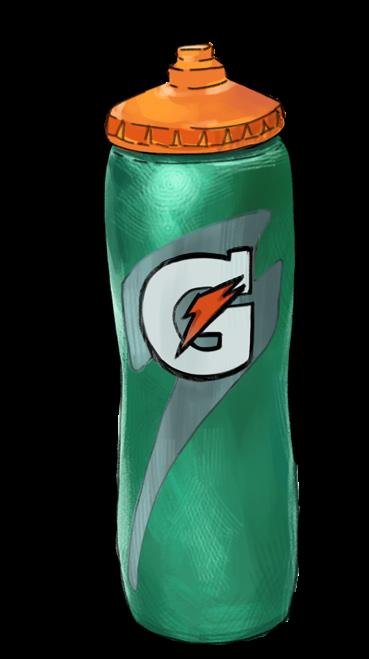
Lastly, I need to have my orange Nike headband with me. I learned how to play !eld hockey this summer at sports camps and won an award for“Best Attitude,” receiving my treasured headband. I cannot wear it every game because it is a little small and gives me a headache; however, when I do wear the headband, I think

the simplest one: shin guards, hockey socks, hockey pants, skates, tuck skate tongues, shoulder pads, elbow pads, jersey, neck guard, helmet, gloves and !nally my stick.
It's a long process, but it’s worth it in the end if it means I can have hockey swag and play the sport I love. Repeating the same routine is just part of the sport, and I will continue rest of

scratchy from too many wears, but these are the ones infused with luck, so I am regrettably unable to move on to a di e imagery of donuts is addi tionally suboptimal, as the last thing I want to be thinking about while actively running as fast as I can and teetering on the edge of passing out is donuts.
Races where these socks were forgotten or lost have been disastrous, such as the time I tumbled over a hurdle during my !rst ever indoor track race and my legs were so badly cut.
In order to avoid such injuries, my advice
is brings me to my next point, which is my crazy superstition about hockey pucks. Once I am dressed and ready to play, I am prepared to work my hardest in practice. But before doing the drill, I look through the pile of pucks to observe the logos, the condition — is it beat up? — and how much snow is on it — is it sticky? If I see a puck with a logo from a professional team I like to watch, I count it as good luck and take that puck with me to shoot on the net.
To test the stickiness and drag of the puck, I stick handle for a few seconds to make sure it is fast and smooth. When I pick out a nice puck, I like to think of it as a lucky charm. for success in sports is to do as I do. Wear the same pair of socks and never wash them — bonus points if they’re decorated with donuts!


Happy Halloween from the Lion's Roar!

2) Issue of contention on the upcoming Nov. 4 ballot (pg. 6)
3) Apt portmanteau for South's very own Jared Mi (pg. 22)
5) Unconventional setting for English teacher Emily Glickman's education work at Tufts
8) What kind of witch likes the beach? A ______!
10) Red Sox player Rafael traded during their rollercoaster of a season... third base drama who? (pg. 20)
11) Items that come in pairs (and sometimes feature donuts!) that many sports fans build superstitions around (pg. 22)
12) Colombian-American singer Kali who recently released her album "Sincerely," (pg. 9).
14.) “Colorful o ering popular with kids at the Newton Harvest Fair (pg. 15).
15) Organization cracking down on fare evasion (abbr.) (pg. 3).
17) Beloved primatologist Jane who passed away Oct. 1.
18) Number between 67 and 69 that could use some love right now.
1) Popular grocery destination coming to Needham Street (pg. 2)
4) Nationwide Oct. 19 protests against Trump's adminstration.
6) U.S. _____ and Customs Enforcement (ICE), agency whose presence is on the rise in Massachusetts (pg. 8).
7) 100 ____, underrated candy bar full of caramel and crisped rice in Massachusetts (pg. 8).
9) Colloquial term for looking through bad news or depressing content on one's phone for long periods of time
13) Rude Rabbit; 2026 Superbowl performer.
16) French museum that was recently the target of an Ocean's 8-style jewelry heist




ANSWERS:


Uchis, Bad Bunny, facepainting, MBTA, Louvre, Goodall, sixty-eight
Trader Joe's, parking, mathlete, No Kings, prison, immigration, Grand, sandwich, Devers, socks,



Aquarius (Jan. 20-Feb. 18): Sometimes Halloween parties are overrated. Go grab a blanket and those Halloween PJs and turn on some Net!ix.
Pisces (Feb. 19-March 20):
Couples costumes aren't all they're cracked up to be. Imagine going as six and seven... scarier than P&P reading due tomorrow.
Aries (March 21-April 19): You only have a week until Halloween. Let's lock in on this costume business, please.
Taurus (April 20-May 20):
We don't know how to say this... your costume... it's a little too niche. Halloween is more fun when everyone's in on the joke.
Gemini (May 21- June 20): Maybe reschedule that November dentist appointment. And try not to choke. Bottom line, take it easy on the candy this year.
Cancer (June 21- July 22): Don't be the toothbrush house. "is goes beyond Halloween. Live in the moment, have fun, and don't be scared of a lil sugar. You won't regret it.
Leo (July 23- Aug. 22): Your night will be spent party-hopping. It's great that you've got a lot of costumes, but did you think through the logistics?
Virgo (Aug. 23- Sept. 22): You don't need to climb deep into the box to nd the perfect pumpkin. Every pumpkin in the patch is special in its own way.

I know what you’re thinking: you’re on the fence. Halloween is just around the corner and you have no idea what to do. Your options consist of the following: watch a scary movie with the friend group, force your way into a party you’re not invited to, or go trick-or-treating.
If you’re anything like me (afraid of scary movies and even more afraid of talking to girls), you know that trick-or-treating is the best option. But the real question is “are you too old?” You really want that 10+ pounds of free candy, but at the same time you don’t want people to call you out.
"ere are probably kids in your grade who think high schoolers are too old to go trickor-treating, but guess what: they’re not fooling anyone. "ey can act all high and mighty, but I know damn well their mothers are still making them PBJ’s for your lunch cut diagonally just like how they like it. On top of that, those are the kids who lurk in the back of parties drinking juice boxes and checking the weather app. On top of that, they’re unemployed.
I’m completely pro trick-or-treating, but today I’m here to draw a line in the dirt and set clear boundaries for what makes someone ineligible to go trick-or-treating.
If you’re over 5 '10. You no longer can pass as a kid simply because of your height so it’s time for you to hang up the boots. You’re going to stick out like a sore thumb amongst the kids and probably get some sus looks from parents. "is includes myself because I’m 6 '2 (6' 2 btw, I wake up at 7AM to lift weights, drink matcha, and I love women’s literature).
If you’re a senior or older. "is is just too old my boy. You’re most likely going to college next year so you really need to grow up. What are you going to say to your roommate? “Hey let’s go trick-or-treating?” Embarrassing. Disappointing. Rubbish.

Libra (Sept. 23- Oct. 22): Don't worry, you'll win your punpkin decorating contest... and if you don't, well, they're called "e Smashing Pumpkins for a reason.
Scorpio (Oct. 23- Nov. 21): 'Tis the season... for Trader Joe's! Hop in that car, grab that cart, and take a nice deep inhale at the door. Smell that? Smells like fall to me!
Sagittarius (Nov. 22- Dec. 21): It's not real. It's not real. IT'S NOT REAL. You might want to sleep with the lights on after your horror movie marathon this year.
Capricorn (Dec. 22- Jan. 19): Sure, you're a little old for trick-or-treating — but you're never too old for stealing! Dump that bowl out like there's no tomorrow.
If you have facial hair. If you’re one of those guys who can grow a short beard between A block and D block on Monday, then you’re out of luck. Parents are going to think you’re a small adult. Sorry Unc.
If the friend group says no. Look, you want to spend the night with the boys, and if they’re not feeling it, it’s a no go. If group leader says no, then you should obey and beg for forgiveness.
If your local law prohibits you. According to Google AI, Bathurst, New Brunswick, Canada has a law that prohibits anyone younger than 16 from ringing doorbells. It’s unclear whether trick-or-treating is a no go because it only explicitly says “no” to doorbell rings. Does knocking on the door count? What about a ring doorbell? How does that play into all of this? Let’s gure that out Google AI. Let’s gure that out Bathurst representatives.
And there’s my quick guide. Always remember, though: stay safe and stay out of the Dale.

By Hana Futai & Ellie Shim






